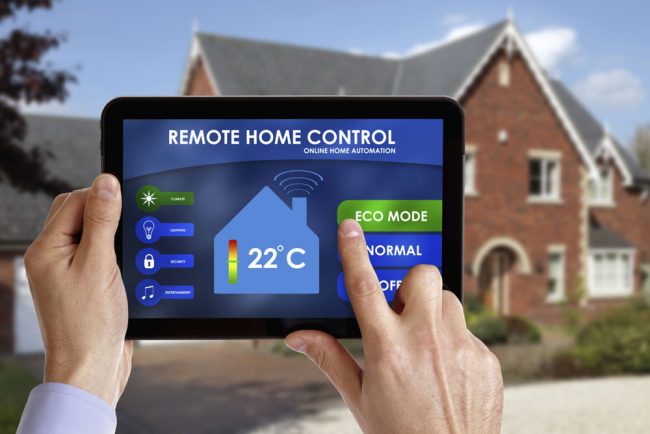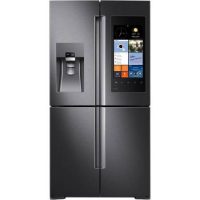
The term smart home may be reminiscent of the Jetson’s 21st-century dwelling with all its futuristic conveniences. But homes equipped with intelligent devices that can send and receive data over networks to consumers are not a thing of the future. The technology behind an intelligent home is here now and more and more companies are jumping onto the smart home bandwagon.
According to Gartner Research, it is estimated that around 25 billion internet of things (IoT) enabled devices will be available by 2020 and an average home could be fully connected with more than 500 IoT devices. Every aspect of maintaining a home will soon have a smart device attached to it.
In an IoT connected home, devices are generally connected to a wireless hub that communicates with the devices directly or with the consumer’s smartphone. Lights, heating and cooling, ventilation, security systems and alarms, electronics, and even garage door access can be controlled and monitored by the user’s smartphone, tablet, or computer.
The Use of Smart Homes
Smart homes are used primarily for home security, automating utilities, health monitoring, and entertainment. Home security seems to be the number one driver in the race towards smart homes with utility monitoring coming in second as a top desire for home automation. Companies like smart72 are beginning to offer customers customized technology to automate their homes for round the clock security plus heating, cooling, and electricity monitoring.
Home Security
Home security automation offers features that conventional security systems don’t. The ability to get continuous real-time updates helps customers to feel like their home is more secure. According to the State of the Smart Home Report put out by Icontrol Networks in 2015, 90% of consumers surveyed cited home security as the number one reason they would update to a smart home.
Smart home security gets ahead of the curve by alerting users before a break-in even occurs. Continual access to their security system allows consumers to set what type of alerts they want and what method they want to receive them with: email, text, phone call, or push notification. Connected homes are equipped with motion sensors and a camera that snaps a picture so homeowners know not just that an alarm was tripped but also what caused it. These new image sensors relay information quicker than traditional security cameras and video from the image sensors can easily be stored in the cloud or another storage device.
Monitoring Utilities
Utility monitoring systems are the second reason consumers buy smart devices and these systems can save consumers a bundle on energy costs every year. Having a blueprint of how much energy they consume on a daily basis allows customers to find potential cost savings all around the home. According to a study done by Nest, a smart thermostat can save a consumer anywhere from 10%-15% on heating and cooling bills and reduce energy usage by roughly 17.5%.
By managing devices such as smart lights, smart fans, smart air conditioning, and smart switches and outlets, consumers can turn their home into an intelligent, energy-efficient space. On top of utilities, devices that track carbon monoxide, fire, and smoke, and temperature gives homeowners confidence that their home is being looked after while they’re away.
Entertainment and Appliances
Smart appliances and entertainment are the third biggest drivers of consumer interest in IoT-enabled devices and since eMarketer predicts that 34% of the world will own a smartphone by 2017, consumers’ need to be constantly connected will only increase.
Adding IoT capability into home appliances and electronics allows consumers to manage their entire household with smart washing machines, refrigerators, coffee makers, microwaves, televisions, home theater systems, and more. The smart functions added into these appliances help users to accomplish household chores by setting functions to run automatically and monitoring and controlling devices remotely for energy efficiency and time management.
Syncing the Tech
 As the technology advances, more and more companies are creating devices that can connect to the internet. Big tech companies like Samsung are trying to stay ahead of the curve by offering customers technology that allows them to be connected 24/7. Take their new Family Hub French Door Refrigerator for example. One of the main obstacles to consumers adopting smart home products, however, is the ability of the devices to work in sync with one another. Machine to machine communication is improving, but tech companies must work together to create seamless connectivity in order to ensure smart home and IoT device adoption.
As the technology advances, more and more companies are creating devices that can connect to the internet. Big tech companies like Samsung are trying to stay ahead of the curve by offering customers technology that allows them to be connected 24/7. Take their new Family Hub French Door Refrigerator for example. One of the main obstacles to consumers adopting smart home products, however, is the ability of the devices to work in sync with one another. Machine to machine communication is improving, but tech companies must work together to create seamless connectivity in order to ensure smart home and IoT device adoption.
While technology hasn’t quite caught up to the Jetsons with flying cars and food replicators, the family of the future wasn’t entirely off with its 21st-century predictions. Today we have smart watches, video conferences, flat screen TVs, robots, space travel, and now smart homes. Automating our homes seems the next logical step to bring the internet of things into full fruition. And who knows? Maybe flying cars and food replicators aren’t as far off as we think.



